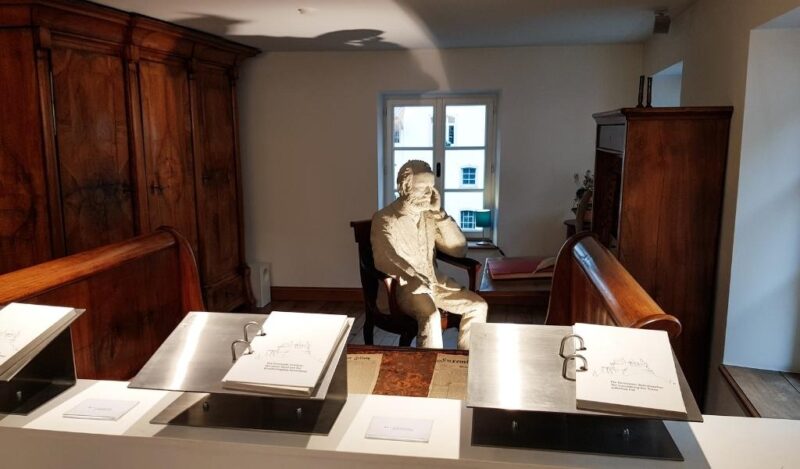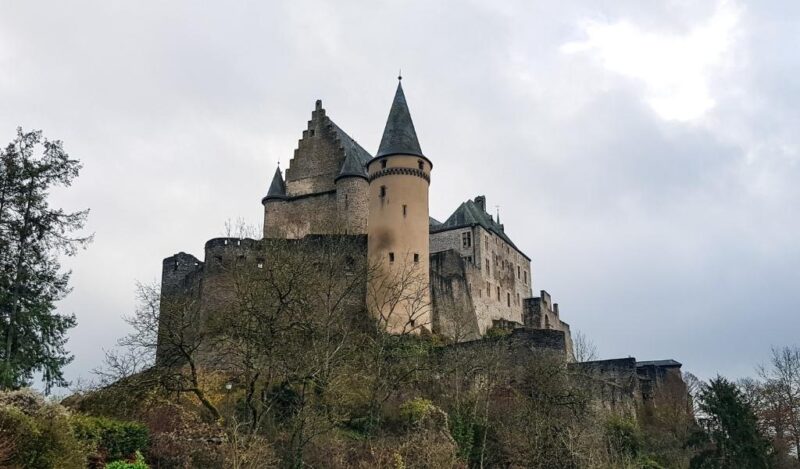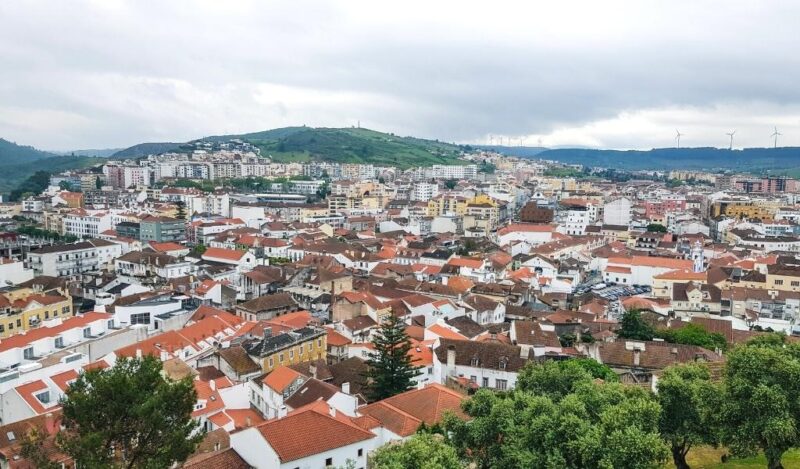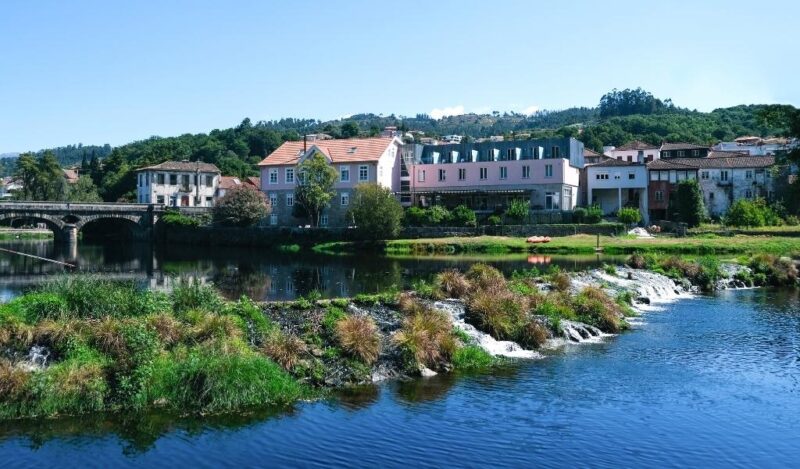Vianden (in Luxembourgish, Veianen or Veinen) is, simultaneously, a town, a commune, and the capital of a canton of the same name, located in the district of Diekirch (in Luxembourgish, Dikrech) and the region of Oesling or Ösling (in Luxembourgish, Eislek), in the northeast of the Grand Duchy of Luxembourg.
Despite having just over two thousand inhabitants, the small town is one of the most tourist destinations in Luxembourg, because of the Vianden Castle. Besides the castle, one of the best things to do in Vianden is to visit the Victor Hugo House – Literary Museum, the building where the famous French writer lived during his stay in the country!
So, do you want to know more about 1 Day In Vianden: The Perfect Vianden Itinerary? Keep reading!
This post may contain affiliate links, meaning I earn a small commission if you make a purchase, at no additional cost to you. Please read my disclosure & privacy policy for more information.
No time to read now? Pin it for later!


Brief History of Vianden
The origins of Vianden date back to the Roman Empire, more precisely to the Gallo-Roman period. The Vianden Castle was built on the ruins of a late-Roman castellum, dating from the 4th-5th centuries! And at that time, the town of Vianden was known as “Viennensis” and portrayed as a very favorable place for the cultivation of vines.
From the Middle Ages onwards, the history of Vianden is intertwined with that of the powerful Counts of Vianden, the feudal lords of this region, and the founders of the Vianden Castle. Therefore, the town grew at the foot of the castle, protected by strong walls and more than twenty watchtowers.
In the 15th century, Vianden was the third-largest city in Luxembourg and had become a true “cultural center of handicrafts”. Coming from various parts of the country (and even abroad), the dozens of artisans who settled here were divided into seven professions: cooper, goldsmith, locksmith, stonemason, tailor, tanner, and weaver.

Unfortunately, the descendants of the Counts of Vianden moved to the Netherlands and ended up selling the monument to a local merchant in 1820, who left it in ruins. And before that, the town had already seen the County of Vianden being abolished by French troops in 1794, and many villages of this former county passed into the possession of the Kingdom of Prussia in 1815!
The Vianden Castle was, in the meantime, recovered by the Grand Ducal Family of Luxembourg and restored almost in its entirety. On the other hand, the town of Vianden never returned to its former glory, largely due to the damage and losses suffered in the First and Second World Wars. Vianden was the last place in Luxembourg to be liberated by the Allies, on February 12th, 1945!
Visiting Vianden
Most tourists visit the town of Vianden on a day trip from the capital of Luxembourg and that’s exactly what I did. Well, to get to Vianden, you must first take a train from Gare de Luxembourg to Gare de Troisvierges.
However, you’ll get off at Gare de Ettelbruck and take bus 570 towards Obereisenbach, Bei der Baach. Once again, you don’t get to do the whole route, as you’ll get off at Gare de Vianden. This trip from Luxembourg to Vianden takes about 1 hour, including changing from the train to the bus in Ettelbruck.
TIP: If you’re thinking of visiting multiple museums and monuments in Luxembourg, then the LuxembourgCard is an excellent option to consider. With prices ranging from €13 to €68, this tourist card is valid for 1 year and can be used by 1 to 5 people, between 1 to 3 days!
Vianden Itinerary
Chairlift
After arriving at Gare de Vianden, there are three ways to go up to the town’s main attraction (that is, the Vianden Castle): on foot, by bus, or by chairlift. The Vianden Chairlift is the only cable car in the Grand Duchy of Luxembourg and offers panoramic views over the Our Valley at an altitude of 220-440 meters!
A one-way trip costs €4.30 (adults) or €2.70 (children up to 14 years old), while a return trip costs €5.80 or €3.30. And in both cases, LuxembourgCard holders don’t pay admission. Regarding opening hours, these depend on the time of year:
- Low season (from Spring to June 22nd and from September 1st to October 10th) – from 11 am to 5 pm (from Monday to Friday) or from 10 am to 6 pm (on weekends and holidays)
- High season (June 23rd to August 31st) – from 11 am to 6 pm (from Monday to Friday) or from 10 am to 7 pm (on weekends and holidays)
WARNING: Between October 11th and the beginning of Spring, the Vianden Chairlift is out of service!
Castle & Walls
Exploring Vianden Castle is, undoubtedly, one of the best things to do in Vianden (and in the Grand Duchy of Luxembourg). Especially since this medieval fortress is not only one of the most beautiful feudal residences in Europe but also an authentic masterpiece of Romanesque and Gothic architecture!


Vianden Castle is open every day, from 10 am to 4 pm (from November to February), from 10 am to 5 pm (in March and October), or from 10 am to 6 pm (from April to September). As for tickets, they cost €10 (adults), 5€ (students), or €2.5 (children from 6 to 12 years old), and LuxembourgCard holders don’t pay admission.
Read my complete guide to Vianden Castle, a must-see tourist attraction on any Vianden itinerary!
Vianden Town Museum
Located a few meters from Vianden Castle, the Vianden Town Museum explains what life was like for the inhabitants of this Luxembourgish town, through a series of thematic exhibitions. One is dedicated to Edmond de la Fontaine (or Dicks), Luxembourg‘s national poet and author of the first Vianden travel guide!

The Vianden Town Museum is open from Tuesday to Sunday, from 11 am to 5 pm (from Easter to October 31st), but it operates every day in July and August. As for tickets, they cost €3 (adults) or €1.5 (children from 6 to 12 years old), and LuxembourgCard holders don’t pay admission.
WARNING: Between November 1st and Easter, the Vianden Town Museum is closed to the public!
Trinitarian Church
In 1248, Count Henry I of Vianden donated a hospice to the Order of the Trinitarians, as a way of thanking them for the release of his father (Count Frederick III of Vianden), who had been captured in a crusade. The foundation of the Convent and Church of the Trinitarians in Vianden dates from the same year.


Despite successive expansions and interventions until the 19th century, the Trinitarian Church of Vianden still maintains its Gothic architecture, of which the two parallel naves and a large cloister on one of the sides stand out. Inside, take the opportunity to admire the altar of the Blessed Sacrament (from 1618) and the high altar (1758)!
War Memorial
As I mentioned earlier, the town of Vianden has been the target of invasions and attacks since the time of Napoleon Bonaparte. But the event that was most marked (for the worst reasons) in the memory of its inhabitants was the Second World War.
This War Memorial is located behind the Trinitarian Church, in the heart of Place de la Résistance (or Resistance Square, now converted into a car park).

The statue consists of a female figure, who’s holding a shield with a lion. Originating from the coats of arms of House Nassau (one of the aristocratic dynasties that ruled the County of Vianden), this lion is still used today by the Grand Dukes of Luxembourg and the Kings of the Netherlands (both descendants of the Nassau Family)!
Sodality Chapel
The Sodality Chapel (in French, Chapelle de la Sodalité; and in German, Sodalitätskapelle) was built by a Tyrolean mason named Jean Hell, between the years 1760 and 1761.
The name of this small Catholic temple can also be translated into English as “Confraternity Chapel” or “Congregation Chapel”. This is because the chapel was offered to the “Sodalité Mariale” (which means “Marian Confraternity” or “Marian Congregation”).

According to historical records, the Sodality Chapel was built on top of an old school, which already existed at that time. Inside, the main altarpiece, furniture, and other decorations date from the Baroque period.
Town Hall
In European countries where German is the language or one of the official languages (such as Austria, Belgium, Germany, Liechtenstein, Luxembourg, and Switzerland), the building where the Town Hall is located is called Rathaus or Stadthaus. And, as you can see from the photograph, the town of Vianden is no exception (“Stadhaus” is the Luxembourgish spelling).

Established in a magnificent historic building, Viaden’s Town Hall accommodates the main administrative services of the town. You can find it on Place Victor Abens, a square that also houses a monument dedicated to this famous Luxembourgish politician.
Our Bridge
As you may have already guessed from the name, the Our Bridge crosses the Our (the river that divides the town of Vianden in two). And, despite being quite small and narrow, I think this monument should be valued more by tourists visiting Vianden. Not least because some of the “best things to do in Vianden” can be done here!


For example, the Our Bridge is an amazing place to admire Vianden Castle. Besides, two sculptures integrate this bridge and deserve to be photographed: a statue of Saint John of Nepomuk (in the center) and a bust of Victor Hugo (at one end and right in front of the Victor Hugo House – Literary Museum)!
Victor Hugo House – Literary Museum
The Victor Hugo House – Literary Museum (in Luxembourgish, Victor Hugo Haus – Literaturmusée; in French, Maison Victor Hugo – Musée littéraire; and in German, Victor Hugo Haus – Literatur Museum) in Vianden is one of the most famous museums in Luxembourg, in addition to being the first literary museum to be inaugurated in the country.
The famous French writer Victor Hugo lived in this building for two and a half months as a political refugee. Author of the historical novels “Notre-Dame de Paris” (1831) and “Les Misérables” (1862), Victor Hugo moved to this town after having visited it three times and having fallen in love with the ruins of Vianden Castle!
The Victor Hugo House – Literary Museum is open every day from 11 am to 5 pm (from early November to mid-April) or from 12 pm to 6 pm (from mid-April to late October). As for tickets, these cost €5 (adults) or €4.5 (groups of 10 people), while those under 25 years old and LuxembourgCard holders don’t pay admission.
Read my complete guide to Victor Hugo House – Literary Museum, a must-see tourist attraction on any Vianden itinerary!
Church of St. Nicholas
The Church of St. Nicholas is (together with the Victor Hugo House – Literary Museum) the only point of interest in the “Lower Town” of Vianden that I highlighted in this itinerary. It was built at the end of the 13th century by the Knights Templar, at a time when the town was still divided into two parishes.


But did you know that this small temple was partially destroyed in a fire, in 1723? The building you see now is a reconstruction, started the following year. Finally, it’s important to note that the Church of St. Nicholas is about 350 meters from the Gare de Vianden, which makes it the ideal stop to finish this Vianden itinerary!
Map of the Vianden Itinerary
Share this blog post on your social media!
More Posts about Luxembourg
10 Best Places To Visit In Luxembourg
Victor Hugo House – Literary Museum: Best Tips For Visiting In 2024
Vianden Castle: Best Tips For Visiting In 2024
More Posts about Travel Itineraries
1 Day In Penafiel: The Perfect Penafiel Itinerary
1 Day In Torres Vedras: The Perfect Torres Vedras Itinerary
2 Days In Arcos De Valdevez: The Perfect Arcos De Valdevez Itinerary
What Photography Gear Do I Use?
- Camera Body: Fujifilm X-T4 Mirrorless
- Camera Lens: Fujinon XF 18-55 mm F2.8-4 R LM OIS
- Tripod: Manfrotto Compact Action
- Small Tripod: Manfrotto PIXI Mini
- Smartphone Adaptor: Manfrotto PIXI Clamp
- Memory Card: SanDisk 128GB Extreme PRO SDXC






